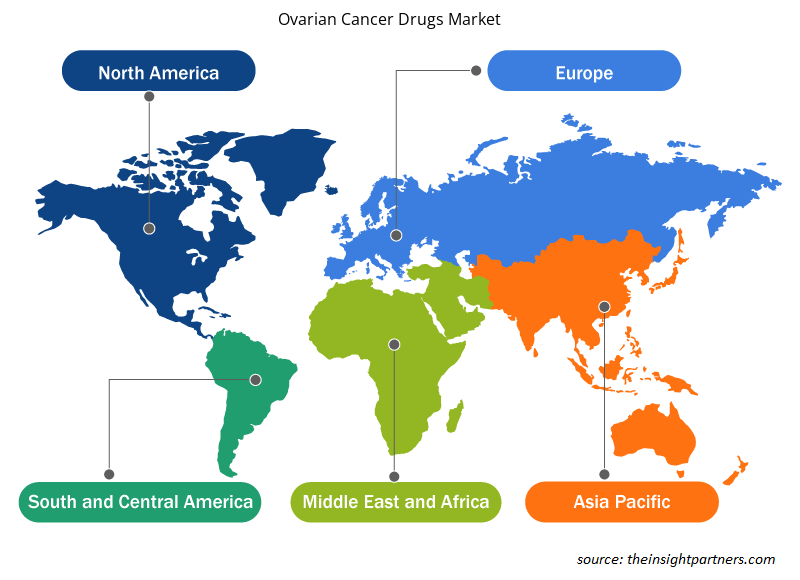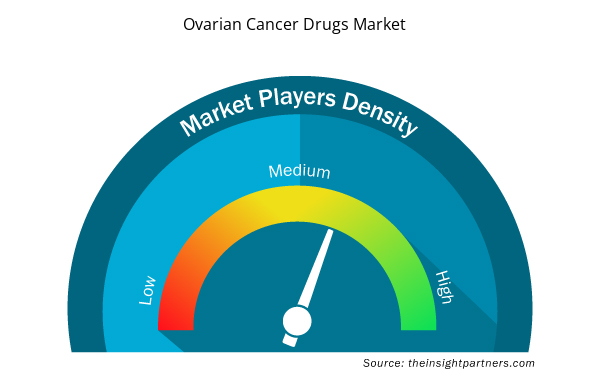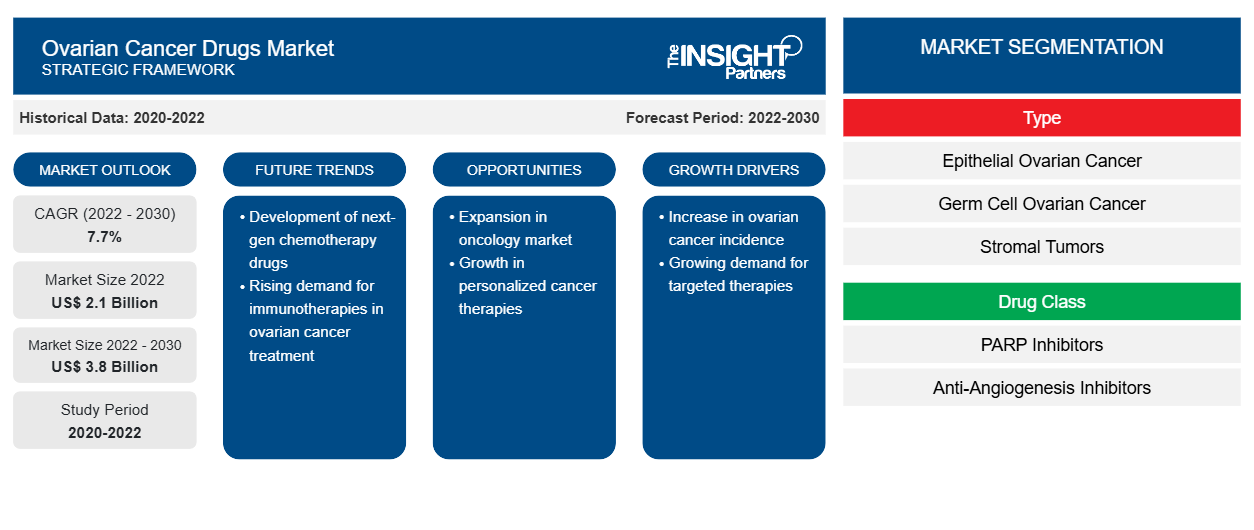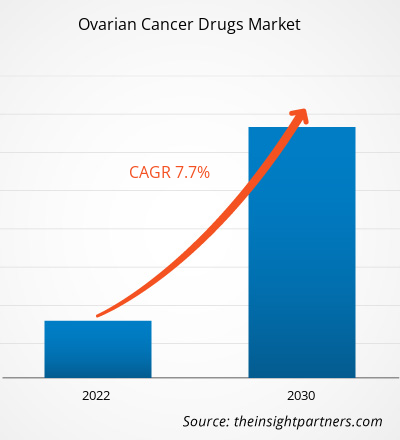[Informe de investigación] Se proyecta que el tamaño del mercado de medicamentos contra el cáncer de ovario crecerá de US$ 2.1 mil millones en 2022 a US$ 3.8 mil millones en 2030; se estima que el mercado registrará una CAGR del 7,7% durante 2022-2030.
Perspectivas del mercado y opinión de analistas:
La creciente incidencia del cáncer de ovario impulsa el crecimiento del mercado de medicamentos contra esta enfermedad . Sin embargo, las retiradas de productos debido a efectos adversos impiden el crecimiento del mercado.
Factores impulsores del crecimiento:
La creciente incidencia del cáncer de ovario aumenta la demanda de opciones terapéuticas
El cáncer de ovario es el séptimo cáncer más común entre las mujeres y la tercera neoplasia maligna ginecológica más común, después del cáncer de cuello uterino y los cánceres de endometrio (útero), respectivamente. Según el informe de la Coalición Mundial contra el Cáncer de Ovarios, 324.000 mujeres son diagnosticadas con cáncer de ovario y 207.000 mujeres mueren de la enfermedad anualmente. Además, la mayoría de las pacientes con cáncer de ovario son diagnosticadas con una enfermedad en etapa avanzada (localmente avanzada o metastásica) ya que no existe un programa de detección de salud pública disponible para la detección temprana del cáncer de ovario. Por lo tanto, la creciente incidencia del cáncer de ovario impulsa la demanda de opciones terapéuticas efectivas. La terapia de primera línea con una combinación de cirugía de reducción de masa y quimioterapia basada en platino es el tratamiento estándar para las mujeres recién diagnosticadas con cáncer de ovario avanzado. Además, las opciones terapéuticas como los inhibidores de PARP aprobados, olaparib, rucaparib y niraparib son las opciones innovadoras para el tratamiento del cáncer de ovario recién diagnosticado. El uso de inhibidores de PARP en el tratamiento del cáncer de ovario avanzado también ha surgido como una opción terapéutica eficaz para mejorar los resultados clínicos. Estos inhibidores proporcionan eficacia a largo plazo y supervivencia libre de progresión (SLP) en los casos recién diagnosticados, tras una respuesta completa (RC) a la primera, segunda y tercera quimioterapia basada en platino.
Personalice este informe según sus necesidades
Obtendrá personalización en cualquier informe, sin cargo, incluidas partes de este informe o análisis a nivel de país, paquete de datos de Excel, así como también grandes ofertas y descuentos para empresas emergentes y universidades.
- Obtenga las principales tendencias clave del mercado de este informe.Esta muestra GRATUITA incluirá análisis de datos, desde tendencias del mercado hasta estimaciones y pronósticos.
Segmentación y alcance del informe:
El análisis del mercado de medicamentos contra el cáncer de ovario se ha realizado considerando los siguientes segmentos: tipo, clase de medicamento y canal de distribución.
Análisis segmental:
Por tipo, el mercado está segmentado en cáncer de ovario epitelial, cáncer de ovario de células germinales y tumores del estroma. El segmento de cáncer de ovario epitelial tuvo la mayor participación de mercado de medicamentos contra el cáncer de ovario en 2022; se prevé que el mismo segmento registre la CAGR más alta del 8,2% durante el período de pronóstico. Según el informe de Cancer Research UK, el cáncer de ovario epitelial es el tipo más común de cáncer de ovario. Por ejemplo, casi 90 de cada 100 tumores de ovario (90%) son tumores epiteliales. Los pacientes con cáncer de ovario agresivo en etapa avanzada tienen opciones de tratamiento limitadas disponibles en el mercado. En noviembre de 2022, la Administración de Alimentos y Medicamentos (FDA) anunció la aprobación de "mirvetuximab soravtansine-gynx", fabricado por Elahere ImmunoGen, Inc. para pacientes adultos que padecen cáncer de ovario epitelial. La dosis recomendada por los médicos de este fármaco candidato para el tratamiento del cáncer epitelial de ovario es de 6 mg/kg, administrada una vez cada tres semanas como infusión intravenosa. En enero de 2024, la FDA anunció la aprobación de la designación de vía rápida (FTD) para "RC88", un conjugado anticuerpo-fármaco (ADC) dirigido a la mesotelina para el tratamiento de pacientes con cáncer epitelial de ovario recurrente. Por lo tanto, el creciente número de aprobaciones de medicamentos está impulsando el mercado de medicamentos contra el cáncer de ovario para el segmento del cáncer epitelial de ovario.
Tendencias del mercado de medicamentos contra el cáncer de ovario
Terapia farmacológica combinada
Varios institutos de investigación médica están desarrollando nuevos fármacos combinados para tratar los cánceres de ovario. En septiembre de 2023, los investigadores del Royal Marsden anunciaron una nueva terapia de combinación de fármacos que demuestra ser eficaz en pacientes que viven con cáncer de ovario avanzado. Los investigadores probaron la terapia de combinación de fármacos para determinar su efecto en el cáncer de ovario seroso de bajo grado (LGSOC), una forma rara de cáncer de ovario con una tasa de respuesta baja a los tratamientos. El ensayo clínico RAMP-201 se llevó a cabo combinando el fármaco avutometinib con defactinib para investigar su efecto terapéutico sinérgico en pacientes que sufren LGSOC. Los resultados provisionales del ensayo clínico revelan que el 45% de los pacientes tratados con la combinación de fármacos vieron sus tumores reducirse significativamente. Estos resultados clínicos satisfactorios con la terapia de combinación son casi el doble de efectivos en comparación con el trametinib, un fármaco de terapia dirigida disponible en Inglaterra que tiene una tasa de respuesta de solo el 26%. En enero de 2024, la FDA anunció la aprobación del fármaco combinado SH-105 para el tratamiento de pacientes con cáncer de mama y de ovario. Por lo tanto, las terapias farmacológicas combinadas están surgiendo como nuevas tendencias que probablemente impulsarán el crecimiento del mercado de medicamentos contra el cáncer de ovario en los próximos años.
Análisis regional:
El alcance del informe del mercado de medicamentos contra el cáncer de ovario incluye América del Norte, Europa, Asia Pacífico, América del Sur y Central, y Oriente Medio y África. En 2022, América del Norte tenía la mayor participación de mercado de medicamentos contra el cáncer de ovario. El crecimiento del mercado en esta región está impulsado por el creciente número de lanzamientos de productos por parte de las principales empresas y la presencia de actores clave del mercado. Estados Unidos es el mayor contribuyente al mercado en América del Norte. La creciente incidencia de cánceres de ovario entre las mujeres obliga a las empresas y a los organismos reguladores a desarrollar y aprobar, respectivamente, medicamentos innovadores en esta región. Además, el creciente número de organizaciones de investigación clínica por contrato (CRO) favorece el crecimiento del mercado de medicamentos contra el cáncer de ovario en América del Norte.
Perspectivas regionales del mercado de medicamentos contra el cáncer de ovario
Los analistas de Insight Partners explicaron en detalle las tendencias y los factores regionales que influyen en el mercado de medicamentos contra el cáncer de ovario durante el período de pronóstico. Esta sección también analiza los segmentos y la geografía del mercado de medicamentos contra el cáncer de ovario en América del Norte, Europa, Asia Pacífico, Oriente Medio y África, y América del Sur y Central.

- Obtenga datos regionales específicos para el mercado de medicamentos contra el cáncer de ovario
Alcance del informe sobre el mercado de medicamentos contra el cáncer de ovario
| Atributo del informe | Detalles |
|---|---|
| Tamaño del mercado en 2022 | US$ 2.1 mil millones |
| Tamaño del mercado en 2030 | 3.800 millones de dólares estadounidenses |
| CAGR global (2022-2030) | 7,7% |
| Datos históricos | 2020-2022 |
| Período de pronóstico | 2022-2030 |
| Segmentos cubiertos | Por tipo
|
| Regiones y países cubiertos | América del norte
|
| Líderes del mercado y perfiles de empresas clave |
|
Densidad de actores del mercado de medicamentos contra el cáncer de ovario: comprensión de su impacto en la dinámica empresarial
El mercado de medicamentos contra el cáncer de ovario está creciendo rápidamente, impulsado por la creciente demanda de los usuarios finales debido a factores como la evolución de las preferencias de los consumidores, los avances tecnológicos y una mayor conciencia de los beneficios del producto. A medida que aumenta la demanda, las empresas amplían sus ofertas, innovan para satisfacer las necesidades de los consumidores y aprovechan las tendencias emergentes, lo que impulsa aún más el crecimiento del mercado.
La densidad de actores del mercado se refiere a la distribución de las empresas o firmas que operan dentro de un mercado o industria en particular. Indica cuántos competidores (actores del mercado) están presentes en un espacio de mercado determinado en relación con su tamaño o valor total de mercado.
Las principales empresas que operan en el mercado de medicamentos contra el cáncer de ovario son:
- Elli Lilly
- AstraZeneca
- GSK
- Sitio web
- InmunoGen
Descargo de responsabilidad : Las empresas enumeradas anteriormente no están clasificadas en ningún orden particular.

- Obtenga una descripción general de los principales actores clave del mercado de medicamentos contra el cáncer de ovario
Desarrollos industriales y oportunidades futuras:
El pronóstico del mercado de medicamentos contra el cáncer de ovario puede ayudar a las partes interesadas en este mercado a planificar sus estrategias de crecimiento. A continuación, se enumeran algunos desarrollos estratégicos de los principales actores que operan en el mercado:
- En noviembre de 2022, ImmunoGen obtuvo la aprobación de la FDA para ELAHERE (mirvetuximab soravtansine-gynx) para el tratamiento de pacientes adultas resistentes al cáncer de ovario epitelial resistente al platino. ELAHERE está aprobado específicamente para pacientes con cáncer de ovario resistente al platino con FRα positivo, que es una afección complicada debido a la disponibilidad de opciones de tratamiento limitadas y los malos resultados clínicos de las terapias existentes.
Panorama competitivo y empresas clave:
Elli Lilly, AstraZeneca, GSK, Zielab, ImmunoGen (AbbVie), GeneTech (Roche), Vivesto, Allarity Therapeutics, Inc., Aeterna Zentaris y Luye Pharma se encuentran entre las empresas destacadas que aparecen en el informe sobre el mercado de medicamentos contra el cáncer de ovario. Estas empresas se centran en el desarrollo de nuevas tecnologías, la mejora de los productos existentes y la expansión de su presencia geográfica para satisfacer la creciente demanda de los consumidores en todo el mundo.
- Análisis histórico (2 años), año base, pronóstico (7 años) con CAGR
- Análisis PEST y FODA
- Tamaño del mercado Valor/volumen: global, regional, nacional
- Industria y panorama competitivo
- Conjunto de datos de Excel


- Trade Promotion Management Software Market
- Micro-Surgical Robot Market
- Human Microbiome Market
- Parking Management Market
- Wind Turbine Composites Market
- Gas Engine Market
- Tortilla Market
- MEMS Foundry Market
- Excimer & Femtosecond Ophthalmic Lasers Market
- Emergency Department Information System (EDIS) Market

Report Coverage
Revenue forecast, Company Analysis, Industry landscape, Growth factors, and Trends

Segment Covered
This text is related
to segments covered.

Regional Scope
North America, Europe, Asia Pacific, Middle East & Africa, South & Central America

Country Scope
This text is related
to country scope.
Preguntas frecuentes
The CAGR value of the ovarian cancer drugs market during the forecasted period of 2022-2030 is 7.7%.
The epithelial ovarian cancer segment held the largest share of the market in the global ovarian cancer drugs market and held the largest market share in 2022.
Ovarian cancer is a growth of cells that is formed in the ovaries where the cells can multiply quickly and invade destroying the healthy body tissues. Therefore, rising prevalence of ovarian cancer among women enhances therapeutic option and drugs.
The PARP inhibitors segment dominated the global ovarian cancer drugs market and held the largest market share in 2022.
The ovarian cancer drugs market majorly consists of the players such Elli Lilly, AstraZeneca, GSK, Zielab, ImmunoGen (AbbVie), GeneTech (Roche), Vivesto, Allarity Therapeutics, Inc., Aeterna Zentaris, and Luye Pharma, and amongst others.
Global ovarian cancer drugs market is segmented by region into North America, Europe, Asia Pacific, Middle East & Africa and South & Central America. North America held the largest market share of the ovarian cancer drugs market in 2022.
Elli Lilly and GeneTech (Roche) are the top two companies that hold huge market shares in the ovarian cancer drugs market.
Trends and growth analysis reports related to Life Sciences : READ MORE..
The List of Companies - Ovarian Cancer Drugs Market
- Elli Lilly
- AstraZeneca
- GSK
- Zielab
- ImmunoGen
- GeneTech (Roche)
- Vivesto
- Allarity Therapeutics, Inc.
- Aeterna Zentaris
- Luye Pharma
The Insight Partners performs research in 4 major stages: Data Collection & Secondary Research, Primary Research, Data Analysis and Data Triangulation & Final Review.
- Data Collection and Secondary Research:
As a market research and consulting firm operating from a decade, we have published and advised several client across the globe. First step for any study will start with an assessment of currently available data and insights from existing reports. Further, historical and current market information is collected from Investor Presentations, Annual Reports, SEC Filings, etc., and other information related to company’s performance and market positioning are gathered from Paid Databases (Factiva, Hoovers, and Reuters) and various other publications available in public domain.
Several associations trade associates, technical forums, institutes, societies and organization are accessed to gain technical as well as market related insights through their publications such as research papers, blogs and press releases related to the studies are referred to get cues about the market. Further, white papers, journals, magazines, and other news articles published in last 3 years are scrutinized and analyzed to understand the current market trends.
- Primary Research:
The primarily interview analysis comprise of data obtained from industry participants interview and answers to survey questions gathered by in-house primary team.
For primary research, interviews are conducted with industry experts/CEOs/Marketing Managers/VPs/Subject Matter Experts from both demand and supply side to get a 360-degree view of the market. The primary team conducts several interviews based on the complexity of the markets to understand the various market trends and dynamics which makes research more credible and precise.
A typical research interview fulfils the following functions:
- Provides first-hand information on the market size, market trends, growth trends, competitive landscape, and outlook
- Validates and strengthens in-house secondary research findings
- Develops the analysis team’s expertise and market understanding
Primary research involves email interactions and telephone interviews for each market, category, segment, and sub-segment across geographies. The participants who typically take part in such a process include, but are not limited to:
- Industry participants: VPs, business development managers, market intelligence managers and national sales managers
- Outside experts: Valuation experts, research analysts and key opinion leaders specializing in the electronics and semiconductor industry.
Below is the breakup of our primary respondents by company, designation, and region:

Once we receive the confirmation from primary research sources or primary respondents, we finalize the base year market estimation and forecast the data as per the macroeconomic and microeconomic factors assessed during data collection.
- Data Analysis:
Once data is validated through both secondary as well as primary respondents, we finalize the market estimations by hypothesis formulation and factor analysis at regional and country level.
- Macro-Economic Factor Analysis:
We analyse macroeconomic indicators such the gross domestic product (GDP), increase in the demand for goods and services across industries, technological advancement, regional economic growth, governmental policies, the influence of COVID-19, PEST analysis, and other aspects. This analysis aids in setting benchmarks for various nations/regions and approximating market splits. Additionally, the general trend of the aforementioned components aid in determining the market's development possibilities.
- Country Level Data:
Various factors that are especially aligned to the country are taken into account to determine the market size for a certain area and country, including the presence of vendors, such as headquarters and offices, the country's GDP, demand patterns, and industry growth. To comprehend the market dynamics for the nation, a number of growth variables, inhibitors, application areas, and current market trends are researched. The aforementioned elements aid in determining the country's overall market's growth potential.
- Company Profile:
The “Table of Contents” is formulated by listing and analyzing more than 25 - 30 companies operating in the market ecosystem across geographies. However, we profile only 10 companies as a standard practice in our syndicate reports. These 10 companies comprise leading, emerging, and regional players. Nonetheless, our analysis is not restricted to the 10 listed companies, we also analyze other companies present in the market to develop a holistic view and understand the prevailing trends. The “Company Profiles” section in the report covers key facts, business description, products & services, financial information, SWOT analysis, and key developments. The financial information presented is extracted from the annual reports and official documents of the publicly listed companies. Upon collecting the information for the sections of respective companies, we verify them via various primary sources and then compile the data in respective company profiles. The company level information helps us in deriving the base number as well as in forecasting the market size.
- Developing Base Number:
Aggregation of sales statistics (2020-2022) and macro-economic factor, and other secondary and primary research insights are utilized to arrive at base number and related market shares for 2022. The data gaps are identified in this step and relevant market data is analyzed, collected from paid primary interviews or databases. On finalizing the base year market size, forecasts are developed on the basis of macro-economic, industry and market growth factors and company level analysis.
- Data Triangulation and Final Review:
The market findings and base year market size calculations are validated from supply as well as demand side. Demand side validations are based on macro-economic factor analysis and benchmarks for respective regions and countries. In case of supply side validations, revenues of major companies are estimated (in case not available) based on industry benchmark, approximate number of employees, product portfolio, and primary interviews revenues are gathered. Further revenue from target product/service segment is assessed to avoid overshooting of market statistics. In case of heavy deviations between supply and demand side values, all thes steps are repeated to achieve synchronization.
We follow an iterative model, wherein we share our research findings with Subject Matter Experts (SME’s) and Key Opinion Leaders (KOLs) until consensus view of the market is not formulated – this model negates any drastic deviation in the opinions of experts. Only validated and universally acceptable research findings are quoted in our reports.
We have important check points that we use to validate our research findings – which we call – data triangulation, where we validate the information, we generate from secondary sources with primary interviews and then we re-validate with our internal data bases and Subject matter experts. This comprehensive model enables us to deliver high quality, reliable data in shortest possible time.


 Obtenga una muestra gratuita de este informe
Obtenga una muestra gratuita de este informe